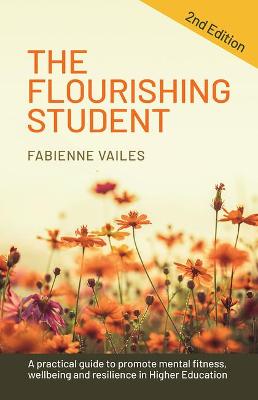Flourishing Student - 2nd edition
 portes grátis
portes grátis
Flourishing Student - 2nd edition
A practical guide to promote mental fitness, wellbeing and resilience in Higher Education
Vailes, Fabienne; Hill, Professor Jenny
Practical Inspiration Publishing
04/2022
258
Mole
Inglês
9781788603331
15 a 20 dias
Descrição não disponível.
Table of Contents
Introduction
Welcome to The Flourishing Student
What is the aim of this book?
Why a book on mental health?
Why a book on HE in particular?
What is this book about?
Who is this book for?
How to use this book
PART I - GAINING UNDERSTANDING AND CLARITY
Chapter 1 - Setting the scene - The current state of student mental health in the UK's Higher Education
The general picture
What about student health?
Why are students reporting getting increasingly stressed?
The issues with our language uses of the words 'mental health'
Mental health - a definition
The confusing impact of multiple negative modifiers
Why so much negativity?
The language we use matters
The danger of labelling oneself and others
The difference between behaviour and identity
Becoming aware of the stigma around mental health
The rise of mental health awareness
Wellbeing and the rise of the concept of embedding wellbeing in the curriculum
Chapter 2 - Time for clarity and understanding - a real need for mental health literacy
The different stages of mental health and why it matters
What's the difference between a disorder and a normal stress response?
Clarification - for whom are the interventions in this book suggested?
The stress response - what happens in our body
The stress response - an issue in the 21st century?
Why stress is good for us
The stress vulnerability model
The stress bucket
Factors of influence on mental health - biological (genetics) and environmental (epigenetics), cultural and social
The good news - neuroplasticity - our capacity for change
What does it mean for the HE sector?
Important final points to consider
PART II - THE IMPLICATIONS FOR EDUCATION
Chapter 3 - Time for a new model?
Emotional, cognitive, physical, social, spiritual health - always kept separate
What if they are all a 'continuum' - Corey Keyes's model as an exemplar
The mental health continuum: from languishing to flourishing in life
What is a flourishing student versus a languishing individual?
WHO's definition of health and link with the new concept of 'flourishing student'
Chapter 4 - A new model based on students' stories
The flourishing student model
The university as a garden
The environment
The roots
The stem
Life and academic skills
The head of the flower
Emotional health
Cognitive health
Physical health
Social health
Spiritual health
Openness
Curiosity
Flexibility
Resilience
Language
How we communicate
PART III - THE TUTOR'S OWN TOOLBOX
Chapter 5 - It all starts with you - the flourishing tutor
How is your mental/physical/social/emotional/spiritual health doing?
Your role - not in isolation but part of a whole
How to create a community instead of an 'institution' which fosters resilience, diversity and student voices
Chapter 6 - Your skills
Listening skills and empathy
Time
Confidentiality
Know your limits - what to say, not to say
Boundaries, boundaries, boundaries - do you know where to refer your students?
Guiding rather than leading
Can you recognize what is going on with your tutees?
Chapter 7 - How to bridge the student's skill gaps
Conscious incompetence versus unconscious competence
How to bridge the gap between knowledge
Letting go of our own labels/bias - how do you define students' success?
The 5 elements that foster wellbeing
Chapter 8 What next?
Understanding
Awareness
A toolbox
The need for a systemic approach
Mental Health charter and whole university approach
A potential model? Appreciative Inquiry
From one colleague to another
Sharing with others
References
Index
Introduction
Welcome to The Flourishing Student
What is the aim of this book?
Why a book on mental health?
Why a book on HE in particular?
What is this book about?
Who is this book for?
How to use this book
PART I - GAINING UNDERSTANDING AND CLARITY
Chapter 1 - Setting the scene - The current state of student mental health in the UK's Higher Education
The general picture
What about student health?
Why are students reporting getting increasingly stressed?
The issues with our language uses of the words 'mental health'
Mental health - a definition
The confusing impact of multiple negative modifiers
Why so much negativity?
The language we use matters
The danger of labelling oneself and others
The difference between behaviour and identity
Becoming aware of the stigma around mental health
The rise of mental health awareness
Wellbeing and the rise of the concept of embedding wellbeing in the curriculum
Chapter 2 - Time for clarity and understanding - a real need for mental health literacy
The different stages of mental health and why it matters
What's the difference between a disorder and a normal stress response?
Clarification - for whom are the interventions in this book suggested?
The stress response - what happens in our body
The stress response - an issue in the 21st century?
Why stress is good for us
The stress vulnerability model
The stress bucket
Factors of influence on mental health - biological (genetics) and environmental (epigenetics), cultural and social
The good news - neuroplasticity - our capacity for change
What does it mean for the HE sector?
Important final points to consider
PART II - THE IMPLICATIONS FOR EDUCATION
Chapter 3 - Time for a new model?
Emotional, cognitive, physical, social, spiritual health - always kept separate
What if they are all a 'continuum' - Corey Keyes's model as an exemplar
The mental health continuum: from languishing to flourishing in life
What is a flourishing student versus a languishing individual?
WHO's definition of health and link with the new concept of 'flourishing student'
Chapter 4 - A new model based on students' stories
The flourishing student model
The university as a garden
The environment
The roots
The stem
Life and academic skills
The head of the flower
Emotional health
Cognitive health
Physical health
Social health
Spiritual health
Openness
Curiosity
Flexibility
Resilience
Language
How we communicate
PART III - THE TUTOR'S OWN TOOLBOX
Chapter 5 - It all starts with you - the flourishing tutor
How is your mental/physical/social/emotional/spiritual health doing?
Your role - not in isolation but part of a whole
How to create a community instead of an 'institution' which fosters resilience, diversity and student voices
Chapter 6 - Your skills
Listening skills and empathy
Time
Confidentiality
Know your limits - what to say, not to say
Boundaries, boundaries, boundaries - do you know where to refer your students?
Guiding rather than leading
Can you recognize what is going on with your tutees?
Chapter 7 - How to bridge the student's skill gaps
Conscious incompetence versus unconscious competence
How to bridge the gap between knowledge
Letting go of our own labels/bias - how do you define students' success?
The 5 elements that foster wellbeing
Chapter 8 What next?
Understanding
Awareness
A toolbox
The need for a systemic approach
Mental Health charter and whole university approach
A potential model? Appreciative Inquiry
From one colleague to another
Sharing with others
References
Index
Este título pertence ao(s) assunto(s) indicados(s). Para ver outros títulos clique no assunto desejado.
Wellbeing;resilience;higher education;young people;stress;anxiety;mental health
Table of Contents
Introduction
Welcome to The Flourishing Student
What is the aim of this book?
Why a book on mental health?
Why a book on HE in particular?
What is this book about?
Who is this book for?
How to use this book
PART I - GAINING UNDERSTANDING AND CLARITY
Chapter 1 - Setting the scene - The current state of student mental health in the UK's Higher Education
The general picture
What about student health?
Why are students reporting getting increasingly stressed?
The issues with our language uses of the words 'mental health'
Mental health - a definition
The confusing impact of multiple negative modifiers
Why so much negativity?
The language we use matters
The danger of labelling oneself and others
The difference between behaviour and identity
Becoming aware of the stigma around mental health
The rise of mental health awareness
Wellbeing and the rise of the concept of embedding wellbeing in the curriculum
Chapter 2 - Time for clarity and understanding - a real need for mental health literacy
The different stages of mental health and why it matters
What's the difference between a disorder and a normal stress response?
Clarification - for whom are the interventions in this book suggested?
The stress response - what happens in our body
The stress response - an issue in the 21st century?
Why stress is good for us
The stress vulnerability model
The stress bucket
Factors of influence on mental health - biological (genetics) and environmental (epigenetics), cultural and social
The good news - neuroplasticity - our capacity for change
What does it mean for the HE sector?
Important final points to consider
PART II - THE IMPLICATIONS FOR EDUCATION
Chapter 3 - Time for a new model?
Emotional, cognitive, physical, social, spiritual health - always kept separate
What if they are all a 'continuum' - Corey Keyes's model as an exemplar
The mental health continuum: from languishing to flourishing in life
What is a flourishing student versus a languishing individual?
WHO's definition of health and link with the new concept of 'flourishing student'
Chapter 4 - A new model based on students' stories
The flourishing student model
The university as a garden
The environment
The roots
The stem
Life and academic skills
The head of the flower
Emotional health
Cognitive health
Physical health
Social health
Spiritual health
Openness
Curiosity
Flexibility
Resilience
Language
How we communicate
PART III - THE TUTOR'S OWN TOOLBOX
Chapter 5 - It all starts with you - the flourishing tutor
How is your mental/physical/social/emotional/spiritual health doing?
Your role - not in isolation but part of a whole
How to create a community instead of an 'institution' which fosters resilience, diversity and student voices
Chapter 6 - Your skills
Listening skills and empathy
Time
Confidentiality
Know your limits - what to say, not to say
Boundaries, boundaries, boundaries - do you know where to refer your students?
Guiding rather than leading
Can you recognize what is going on with your tutees?
Chapter 7 - How to bridge the student's skill gaps
Conscious incompetence versus unconscious competence
How to bridge the gap between knowledge
Letting go of our own labels/bias - how do you define students' success?
The 5 elements that foster wellbeing
Chapter 8 What next?
Understanding
Awareness
A toolbox
The need for a systemic approach
Mental Health charter and whole university approach
A potential model? Appreciative Inquiry
From one colleague to another
Sharing with others
References
Index
Introduction
Welcome to The Flourishing Student
What is the aim of this book?
Why a book on mental health?
Why a book on HE in particular?
What is this book about?
Who is this book for?
How to use this book
PART I - GAINING UNDERSTANDING AND CLARITY
Chapter 1 - Setting the scene - The current state of student mental health in the UK's Higher Education
The general picture
What about student health?
Why are students reporting getting increasingly stressed?
The issues with our language uses of the words 'mental health'
Mental health - a definition
The confusing impact of multiple negative modifiers
Why so much negativity?
The language we use matters
The danger of labelling oneself and others
The difference between behaviour and identity
Becoming aware of the stigma around mental health
The rise of mental health awareness
Wellbeing and the rise of the concept of embedding wellbeing in the curriculum
Chapter 2 - Time for clarity and understanding - a real need for mental health literacy
The different stages of mental health and why it matters
What's the difference between a disorder and a normal stress response?
Clarification - for whom are the interventions in this book suggested?
The stress response - what happens in our body
The stress response - an issue in the 21st century?
Why stress is good for us
The stress vulnerability model
The stress bucket
Factors of influence on mental health - biological (genetics) and environmental (epigenetics), cultural and social
The good news - neuroplasticity - our capacity for change
What does it mean for the HE sector?
Important final points to consider
PART II - THE IMPLICATIONS FOR EDUCATION
Chapter 3 - Time for a new model?
Emotional, cognitive, physical, social, spiritual health - always kept separate
What if they are all a 'continuum' - Corey Keyes's model as an exemplar
The mental health continuum: from languishing to flourishing in life
What is a flourishing student versus a languishing individual?
WHO's definition of health and link with the new concept of 'flourishing student'
Chapter 4 - A new model based on students' stories
The flourishing student model
The university as a garden
The environment
The roots
The stem
Life and academic skills
The head of the flower
Emotional health
Cognitive health
Physical health
Social health
Spiritual health
Openness
Curiosity
Flexibility
Resilience
Language
How we communicate
PART III - THE TUTOR'S OWN TOOLBOX
Chapter 5 - It all starts with you - the flourishing tutor
How is your mental/physical/social/emotional/spiritual health doing?
Your role - not in isolation but part of a whole
How to create a community instead of an 'institution' which fosters resilience, diversity and student voices
Chapter 6 - Your skills
Listening skills and empathy
Time
Confidentiality
Know your limits - what to say, not to say
Boundaries, boundaries, boundaries - do you know where to refer your students?
Guiding rather than leading
Can you recognize what is going on with your tutees?
Chapter 7 - How to bridge the student's skill gaps
Conscious incompetence versus unconscious competence
How to bridge the gap between knowledge
Letting go of our own labels/bias - how do you define students' success?
The 5 elements that foster wellbeing
Chapter 8 What next?
Understanding
Awareness
A toolbox
The need for a systemic approach
Mental Health charter and whole university approach
A potential model? Appreciative Inquiry
From one colleague to another
Sharing with others
References
Index
Este título pertence ao(s) assunto(s) indicados(s). Para ver outros títulos clique no assunto desejado.







